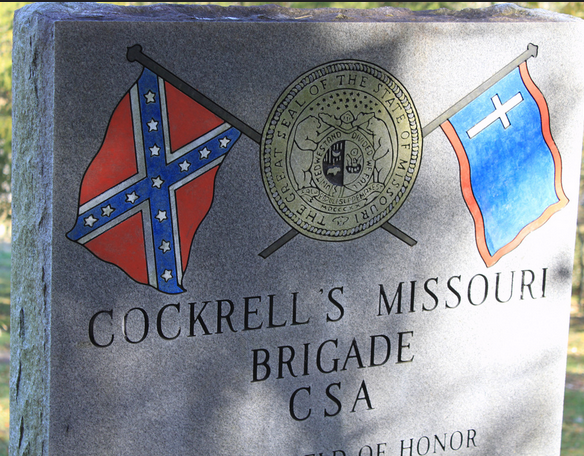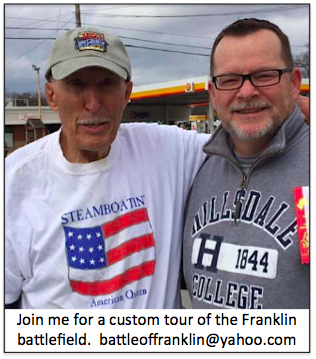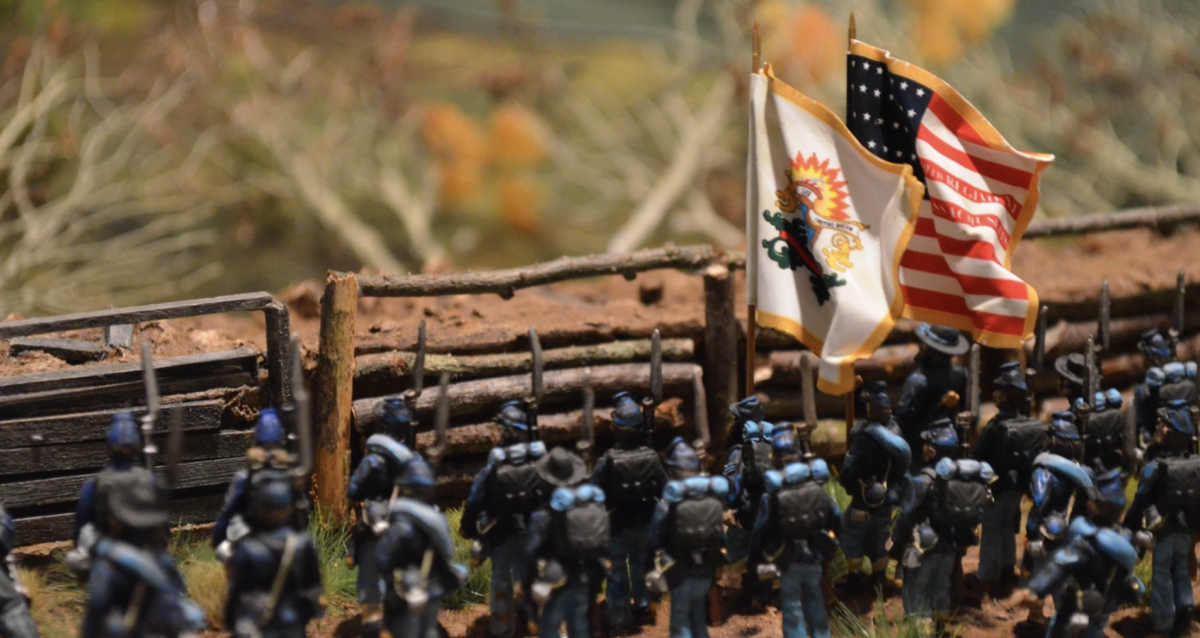Category: Battle description
112th Illinois soldier writes post-Franklin account
Source: http://tennrebgirl.com/cgi-bin/display_Items.asp?Cat=17&Sub=206
Brad Thompson was born in Osceola Illinois, enlisting as a 1st sergeant in Co B, 112th Illinois Volunteer Infantry on Aug 12, 1862. He was promoted to 2nd Lieut March 31, 1863, served as adjutant from Nov 25, 1863, and promoted to captain April 25 1865, prior to his muster out June 20th 1865.
Chaplain the 90th Ohio Infantry writes of Hood’s retreat and Confederate dead after Franklin
The following letter was retrieved online on October 6, 2018 (Cowan’s Auction)
William C. Holliday (1838-1921) was born in Adams County, Ohio. The Minutes of Ohio Annual Conference of Methodist Episcopal Church described him as a “local preacher” as early as 1855. Holliday enlisted on December 21, 1863, as a chaplain and was commissioned into Field & Staff OH 90th Infantry. Holliday mustered out on June 13, 1865 at Camp Harker, TN.
Franklin Tenn Dec 18, 1864
1st Division Hospital 4 AC
Ma
Yesterday morning we moved easily in the AM. Our troops had moved rapidly after the panic stricken and fleeing rebels about four miles. It was night. They slept on the mud and under the rain. It rained all day – but this Army is so flushed with victory that they did splendid marching – though tired and worn from two days incessant fighting and almost sleepless nights. We came about fifteen miles. Rebels are still going. It is the greatest victory of the war….”
And writing to his wife from the Field Hospital ….
Six Miles North Columbia Tenn.”[Dec 19]
Mrs. Holliday,
It is about 7oclock PM. I sent you a very brief letter on the 18 at Franklin. On this same day we marched about 14 miles through the rain. At Franklin I had an opportunity of circling over the battlefield. The rebels suffered terribly. They assaulted our works and were killed by the hundred. I counted on one side the pile over three hundred and fifty graves. There were as many on the other side…”
Source: Cowan’s
120th Indiana soldiers writes extensive post-war account of the Battle of Franklin
Cockrell’s Missourians at Franklin suffered horrific casualties

Brigadier-General Francis M. Cockrell led a brigade under Samuel G. French at Franklin. It was all-Missouri brigade: 1st-4th (Garland), 2nd-6th (Flournoy, Carter), 3rd-5th (Canniff), and 1st-3rd MO Cav dismounted (Gates). Of these, Garland and Canniff were killed, Carter and Gates were wounded. Cockrell himself was lucky, he had two horses shot out from under him and was wounded in the right arm, left leg, and right ankle. Garland was shot while carrying the 1st Missouri flag. Canniff was within ten yards of the line when he was shot.
Cockrell’s men assaulted the Federal line just east of the cotton gin. Jacobson says it is likely that Cockrell’s Missourian’s were the first Confederate’s to hit the Federal line. They would have been warmly greeted by the 65th Indiana Infantry (Casement).
“The Federals obliterated the Missouri ranks, and a Confederate captain said the air “was all red and blue flames, with shells and bullets screeching everywhere…” The barrage was so intense that some of the Missourians actually turned their shoulders into the firestorm and bent down at the knees in the hope of getting through.” [Citation: Jacobson, Eric A.. For Cause and Country: A Study of the Affair at Spring Hill & the Battle of Franklin (Kindle Locations 5978-5980)]

Years after the war Cockrell said the following about Franklin, “When I got these wounds I was at the front line right in the midst of the fight. I tried my right leg, and when I found out i couldn’t walk on it, I hobbled off the field. It was not until the surgeon was working on my right ankle that I found I had been wounded in my left leg.” [Citation: The Civil War Times, December 2017: p. 55]
After the war, Cockrell said this of his brigade at Franklin. “I lost two-thirds [at Franklin] having had every fourth man killed dead, or mortally wounded, and since died. This was by far the fiercest and bloodiest and hottest battle I have ever been in. My Brigade acted more handsomely, defiantly and recklessly than on any field of the war; and you know what it required to eclipse all former conduct on so many bloody fields.”

“They march quietly, and boldly, and steadily through the broken and fleeing ranks of at least twice their own number, and no man wavered – all to the stop, with colors six paces in front, just like a drill, and never brought their guns from a ‘right shoulder shift’ until within thirty or forty yards of the enemy’s works. and then fired by order, and hurled themselves against the works. It was grand and terrible in the extreme.Almost all were killed and wounded very near the works, or in the ditches of the works. I have no language to paint the scene.” [Citation: The Civil War Times, December 2017: p. 55-56.]
Historian Gottshalk (In Deadly Earnest) says that Cockrell had 696 men who went into the fight at Franklin and they suffered 419 total casualties.

Here are the known/identified Missourian’s from Cockrell’s brigade buried at McGavock Confederate Cemetery:
Garland: 1st MO – 8 and 4th MO – 6 for a total of 14 men
Flournoy, Carter: 2nd MO -13 and 6th MO – 7 for a total of 20 men
Canniff: 3rd MO – 15 and 5th MO 11 for a total of 26 men
Gates: 1st MO Cav dis – 10 and 3rd MO Cav dis – 11 for a total of 21 men
Of these 114 total Confederate known-dead at McGavock, Cockrell’s Missourian’s accounted for 81 of the 114.
[Citation: The McGavock Confederate Cemetery (2017): p. 187.]

For further reading:
- Descendant of Cockrell
- 4th Missouri flag at Franklin
- In Deadly Earnest, Gottshalk
Tags: Battle of Franklin | Francis M. Cockrell | Missouri | Indiana | 65th Indiana Infantry | John Casement | Cotton gin | 1st Missouri Infantry | CSA | McGavock Confederate Cemetery | Ed Bearss












